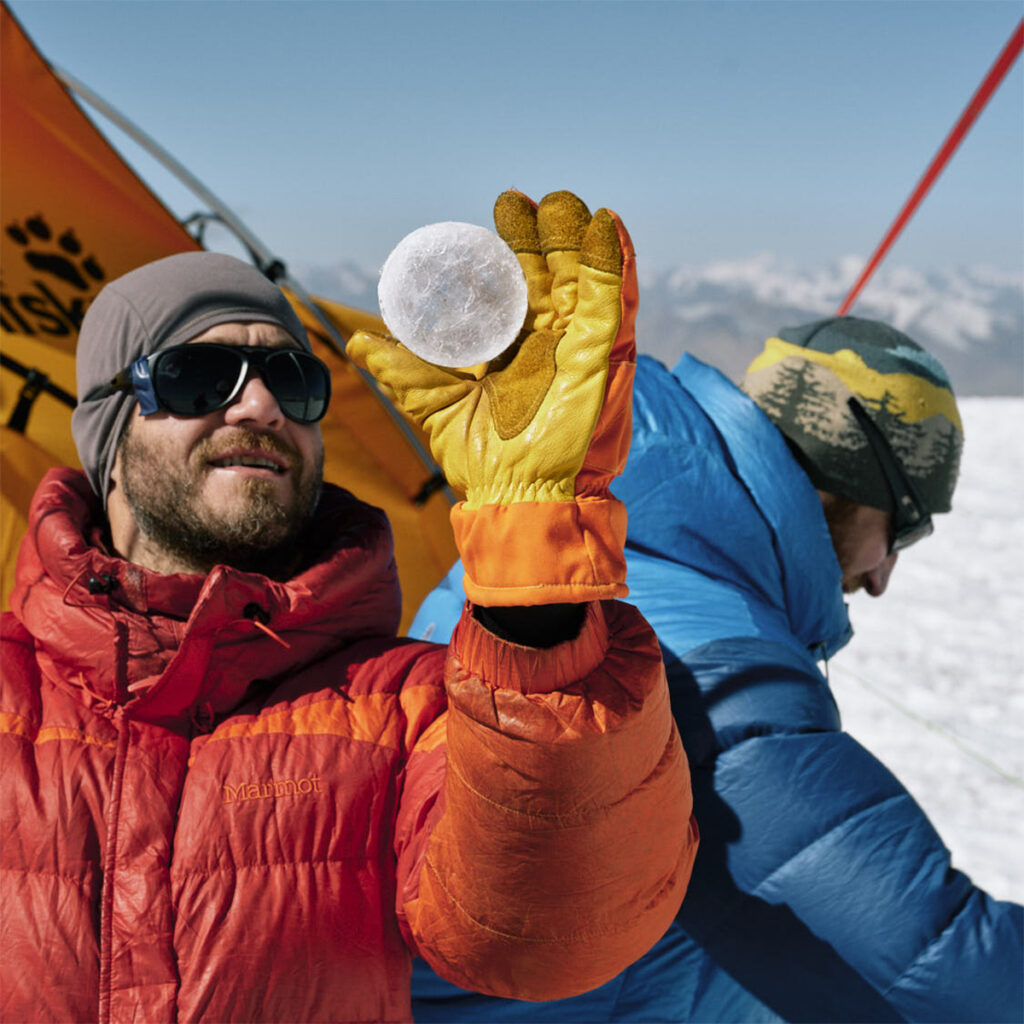Central Asia’s Pamir Mountain Range contains some of the most well-preserved glaciers in the world.
Obtaining cores from a Pamir region glacier has been “almost like a holy grail for ice core scientists,” said Stanislav Kutuzov, a glaciologist at Ohio State University. But logistical challenges thwarted past attempts.
“The scientific community has been trying to take an ice core from this region for a long time.”
Last month, scientists finally did it: Between 27 September and 1 October, 13 researchers successfully drilled three ice cores from Tajikistan’s Kon Chukurbashi ice cap, a glacier 5,800 meters (19,029 feet) above sea level. Researchers expect the cores to contain ice more than 10,000 years old. The cores preserve important climate information that will help scientists better understand glacier evolution and past climate and weather patterns in central Asia.
“I’m still in disbelief that the expedition happened,” said Evan Miles, the expedition’s leader and a glaciologist at the Universität Zürich and the Universität Freiburg. “The scientific community has been trying to take an ice core from this region for a long time.”
The Tajik government formally donated the cores to the international scientific community in a 13 October ceremony. The cores are the first deep, high-elevation, uninterrupted ice archive to be collected in the Pamir region in Asia’s highlands—dubbed Earth’s “Third Pole” for its ice-, snow-, and glacier-covered landscape.
“In the whole region of high-mountain Asia, there is not very much climate information available for longer periods into the past,” said Christoph Mayer, a glaciologist at the Ludwig-Maximilians-Universität München who was not involved in the expedition. With the core, “we can fill a really big research gap in this region,” he said.
A Pamir Core at Last
Scientists have wanted additional glacial cores from this region both because of the region’s long-term, somewhat anomalous stability and because such cores could help them better describe the region’s weather patterns, such as the winter westerly winds that bring moisture to the Pamir range and influence the hydrology of a basin supplying water to millions of people.
Most efforts to obtain Pamir region cores targeted Vanch-Yakh Glacier (formerly Fedchenko Glacier) in Tajikistan. At about 75 kilometers (47 miles) long and more than 1,000 meters (3,281 feet) deep, Vanch-Yakh Glacier was a very desirable object of study.
But the complex terrain surrounding Vanch-Yakh Glacier means it is extremely hard to reach. Since the 1980s, problems with helicopters, difficult-to-obtain permits, and geopolitical tensions have repeatedly thwarted scientists attempting to drill cores there.
Kon Chukurbashi provided an alternate opportunity. This glacier is accessible by road and foot, no helicopter needed.
The international expedition to Kon Chukurbashi was led by the Swiss Polar Institute’s PAMIR Project in partnership with the Ice Memory Foundation and included researchers from the Academy of Science of Tajikistan, Hokkaido University, Nagoya University, and Ohio State University; local porters; drivers; and a media team. The team left to retrieve the ice cores on 14 September.
The expedition began with a 4-day drive on the bumpy Pamir Highway, one of the world’s highest-elevation roads. Researchers required multiple days of acclimatization, first in the Tajik village of Karakul, then at a 5,100-meter-high (16,732-foot-high) base camp, to safely function at the high altitudes. The team carried roughly 1.5 tons of equipment up to the glacier.
“It’s a risky operation every time. We were fortunate.”
The expedition faced additional challenges, Miles said: There were moments when it looked as though permits might not be issued, cars broke down in the middle of nowhere, and a couple members of the team suffered from acute mountain sickness.
In the final year of funding for their project, the expedition was “make or break,” Miles said. But the team succeeded and carried three ice cores—two about 105 meters (345 feet) long and one shallow 22-meter (72-foot) core—in freezer boxes down from the glacier. They also successfully installed instrumentation to monitor the glacier’s future mass changes and completed a radar survey to determine its internal structure.

“It’s a risky operation every time,” said Kutuzov, who was also the team’s lead driller. “We were fortunate.”
Miles and Kutuzov both said they were impressed with the way the international group was able to work together. “It is only due to the resolve and collaborative nature of our team that we managed to find ways forward and continue,” Miles said. Kutuzov found the international collaboration especially encouraging amid the current dearth of federal support for science in the United States.
Probing the Pamir’s Climate History
The three ice cores will eventually travel to three continents for safe storage and study.
One is in the custody of the Ice Memory Foundation, an international organization aiming to collect, save, and manage ice cores from glaciers in danger of degradation or disappearance. The foundation runs a heritage collection of ice cores that it plans to store in Antarctica at Concordia Station, a French- and Italian-run research station, starting in December. (The core is currently in Japan, awaiting travel to Antarctica.) The Ice Memory Foundation provided funding that allowed the expedition team to drill multiple cores rather than one.
The Ice Memory core will be preserved for future generations of scientists who may develop techniques to gather information from the ice that today’s methods aren’t able to access. “It’s a brilliant initiative,” Mayer said.
The second deep core, also currently in Japan, is headed to Hokkaido University, where scientists will investigate long-held questions about weather and climate in central Asia.
“We have huge questions on the paleotimescale, the multiple thousands of years timescale about glaciation fluctuations across this region,” Miles said.

For one, the drivers behind the unique stability of the region’s glaciers compared to the rest of Asia, a phenomenon dubbed the Karakoram Anomaly, have long been a mystery to scientists. It’s clear from satellite data that the anomaly has persisted since about 1970, but scientists don’t know whether it existed before then. Glaciers in the region also have begun to show signs of melting in the past few years, also raising questions about whether the pattern is truly anomalous or simply a result of natural climate variability.
“We really lack the in situ data to understand even the mechanisms by which this anomaly has happened. We are relying almost solely on remote sensing data,” Miles said.
“We have modeling, we have reanalysis, but no actual data,” Kutuzov added.
The new Pamir cores may be able to determine whether the anomaly has occurred in the past, as well as its possible source—one untested hypothesis posits that perhaps an increase in irrigation in the valleys below contributed to an increase in the region’s precipitation and stabilizing the glaciers, for example. “There’s a scientific puzzle,” Kutuzov said.
“Maybe [the anomaly] is a frequent thing that happens every so many decades or centuries,” Mayer said. “That would be something very interesting to understand.”
The cores will also give insight into the past climate and weather patterns governing the region, which will provide context to understand the current weather and climate dynamics that affect the region’s hundreds of millions of people.
“Society is going to have to grapple in the coming decades with rather dramatic changes to the hydrosphere, including the cryosphere. And this is, I think, where we can provide really useful information,” Miles said.
The third, shallow core also traveled to Japan after the expedition but will eventually head to Ohio State University, where it will be used to test new research methodologies.
The expedition and the research it allows honor the United Nations Decade of Action for Cryospheric Sciences and International Year of Glaciers’ Preservation.
—Grace van Deelen (@gvd.bsky.social), Staff Writer
17 November, 2025: This article was updated to reflect the correct date of the beginning of the expedition.


